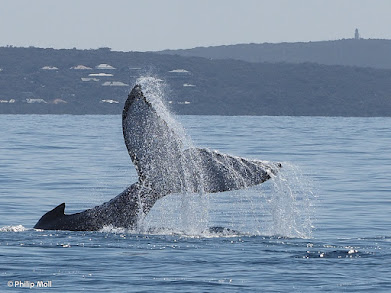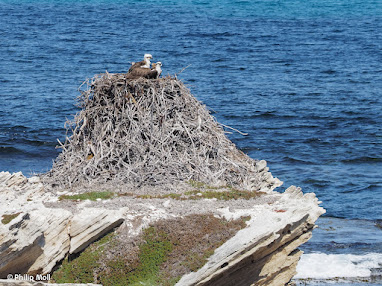It's great to be back in Western Australia enjoying the amazing biodiversity that this region has to offer.
First stop always has to be Wireless hill in Perth a great place to get your eyes into searching for native orchids. It's also a good area to see birds feeding on the kangaroo paw plant.
Then our planned trip further South to Yallingup. On route we tried to locate the Ambergate Reserve at Busselton, but the GPS led us to a highway that seemed to bisect the road we needed. we decided it was better to press on and find this recommended reserve on the way back.
Yallingup is in the Cape Naturaliste National Park. The house we are staying in is surrounded by bush and an ideal area for native orchids including Cowslip Orchid, Spider and purple enamel orchid. Nearby I found two species of round leaved sundew in flower. One with white flowers the other blue flowers.
 |
| Purple Enamel Orchid |
 |
| Cowslip Orchid |
A whale watch boat trip from Dunsborough was excellent with good close sightings of 10 metre humpback whales. The boat keeping to a 100 metre distance to respect the whale's space.
 |
| Tail slap of a humpback whale |
The next day we were exploring a favorite spot, Castle Rock. We found more orchids along the walk to Meelup beach. This included the tiny little pink fairy orchid. From the shore we could also see humpback whales too. No sign of Fairy Wrens on this visit but certainly many honeyeaters busy through the bush.
On previous visits we have also visited the Cape Naturaliste lighthouse and the walk to the whale watch lookout platform. It's a great walk through interesting sandy bush paths the habitat of snakes some venomous and lizards. We did see honey eaters and a pair of Bronzewing doves.
 |
| Cape Naturaliste lighthouse habitat |
 |
| Bronzewing Dove |
The day was heating up to the mid 30 degrees so decided to head for shade with a return visit to Meelup beach to allow us further views of the whales that we had seen from the beach yesterday but not today. However, it's a great place to spend some time.
Then North to search again for the Ambergate reserve near Busselton. This time we were successful and enjoyed seeing Rattlebeak orchids and a species of larger leafed sundew. The temperature today reached 34degrees so hot work searching. Next stop Rockingham for the night.
Refreshed in the morning we continued North to Yanchep staying at an Airbnb close to the Yanchep National Park. We spent a couple of days exploring this beautiful location. Within the plant gardens good sightings of two splendid fairy wrens. This is an amazing little bird of exquisite colour.
 |
| Splendid male Fairy Wren |
Interesting to see the koalas in the enclosures although these are not native to the region. They rest high up in the gum trees and are more active at night. We also spotted a western grey kangaroo with a joey in its pouch.
Tuesday evenings are the regular meeting time of the Pelican Point conservation area birders who have met each week since the 1970's I believe. Now that we are back in Perth, I tag along to their walk around this wetland to count the bird species and their numbers. We count 21 species with common sandpiper, red-capped plover, oystercatcher and black winged stilts (known as pied stilts in NZ) among them. We also estimate a flock of at least 300 + little black cormorants that at one point are chased through the water by a powerboat.
As we travel around, I am aware that there are birds everywhere. The local parks and reserves are full of the sounds of birds, and they are constantly flying around. Corellas fly in flocks and around the lakes near Bold Park I watch them roosting in trees. I have also been aware at the number of large dragonflies around the ponds and lakes. At Bibra lake we watched the strangest duck, a Musk duck, propelling itself in the water displaying its tail feathers. It's very unusual.
It was lovely to catch up with Claire who is now working as a Marine biologist. Claire's specialty is seabirds particularly the Australian fairy tern, so this ties up nicely with my interest and volunteer work with the NZ fairy tern over the years. On Saturday we walked out at the sand spit at Point Walter to check the vegetation ahead of the fairy tern arriving to breed from November onwards.
On Monday morning on a walk between Alfred Cove and Applecross Jetty. We watched at least three fairy tern way out diving for fish. There twittering and flickery flight was sure sign of this species. These early arrivals are no doubt checking out nesting sites.
It's always a must do to revisit Rottnest Island an A class reserve just a half an hour's bout ride from Perth. This car free Island is just great to spend a few days on and explore on foot or by bike. I always have to check out the Osprey nests and on in particular. Perfect timing as the two adults on the nest also had a juvenile with them.
 |
| Osprey stack nest with adult birds and one young bird. |
Tuesday so another catchup with the Pelican Point group. It's great to catch up with Sue Mather who was so helpful when I bumped into her at Rous head at the Fairy tern site and she passed on information about the Bird office in Bold Park and put me in touch with Nic Dunlop regarding Fairy Tern. It was also nice to catch up with John & Bev who I hadn't seen since 2019. This evening there are plenty of birds in the wetland. We count a total of 29 species including two buff banded rails.
 |
| Pelican Point Wetland Reserve |
Explored the wonderful reserves of Lesmurdie and Ellis Brook on the Darling scarp. Ellis Brook was particularly good for wildflowers.
A lucky find in a secondhand bookshop after enjoying a coffee at the Swedish cafe in Fremantle which incidentally serves excellent coffees and food, a clean copy of 'The Flowers of May' by Richard Mabey. I have a collection of Richard Mabey's Natural History books starting with 'Food for Free' which was a great introduction to foraging for wild foods in hedgerows.
It's great to be back on Rottnest Island a wonderful 'A' class reserve a half an hour boat ride away from the Perth mainland at Fremantle. Refreshingly the island is free of cars apart from maintenance vehicles. Cycling is the main means of getting round the island or the bus that runs clockwise every half an hour stopping at the many beautiful white sand beaches. The island has some fascinating wildlife including resident Quokkas.
 |
| Rottnest Island white sand bays |
I head for one of my favorite Osprey nest sites and sure enough an osprey pair have a juvenile still on the nest. Nearby I watch a pair of kestrels one with a freshly caught small lizard.
I've walked out to Woodman point a few times when in Perth in the hope of spotting Fairy Tern but no sign. Just a kestrel hovering over the sand dunes.
A Sunday visit to the beautiful Araluen Botanical gardens in the Perth Hills which are simply quite stunning. The gardens are 90 years old.
 |
| Araluen Botanical Gardens |
Penguin Island today a small island I am always tempted to revisit whenever in WA. It's about 45 mins from Perth and a short boat ride from the shore. It's a bird island managed by the Department of Biodiversity, Conservation and Attractions. It's a great place to see pelicans and Bridled terns and other interesting species. If you are lucky penguins too. Today I was fortunate to meet Erin a penguin researcher who was busy setting up cameras to check the arrival of the penguins and their nesting sites under a coastal boardwalk.
 |
| Penguin Island Conservation Park |
A farewell few hours spent at Point Walter. Its 35 degrees today so the cooling Easterly breeze of the Swan River is very welcome.
More photos to follow..................




